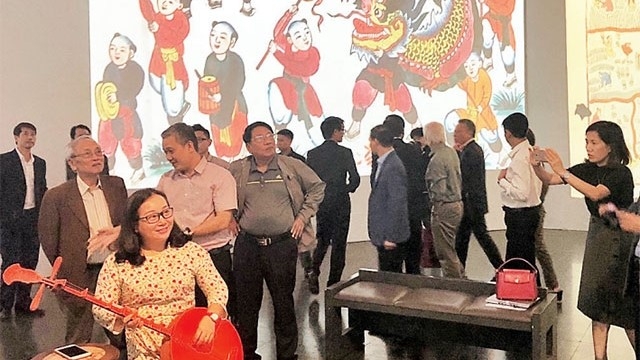The presentation of Hang Trong folk paintings through multimedia technology has emerged as an exemplary method for promoting cultural heritage, particularly among young people.
Hang Trong folk paintings are a distinctive and traditional cultural feature of Hanoians. However, due to their esoteric nature and large volume of paintings for worshipping, few people truly appreciate and enjoy this art form. In late November and early December, the Hanoi Museum held an exhibition on Hang Trong folk paintings, which significantly changed people’s perception of this art. The incorporation of technology played a pivotal role in this transformation.
In addition to showcasing 50 Hang Trong paintings by artisan Le Dinh Nghien and his son Le Hoan, the Hanoi Museum introduced nearly 100 folk paintings using multimedia technology, particularly through 3D mapping. The use of light to create special 3D visual effects on surfaces generated interactive images within a three-dimensional space. Experts digitalized Hang Trong folk paintings and projected them in 3D. The fusion of 3D images and sound produced captivating effects that thrilled the audience.
Visitors to the exhibition also had the opportunity to engage with the paintings. The Hanoi Museum collaborated with experts to apply AI deep learning technology, enabling artificial intelligence to learn the distinct features and styles of Hang Trong folk paintings and generate images of visitors in the style of Hang Trong paintings.
Vu Thuy Ha, a resident of Doi Can Street, Ba Dinh District, expressed her excitement about the exhibition: “In the past, I regarded folk paintings as archaic and found it challenging to appreciate and understand them. However, this exhibition has completely changed my perspective. Even my daughter became curious and fascinated by the idea of becoming a character in a painting. I believe that this innovative approach will attract more people to the world of folk paintings.”
This was the second time the Hanoi Museum employed 3D mapping technology and artificial intelligence to transform visitors into paintings. Previously, on the occasion of the 65th anniversary of Hanoi’s Liberation Day, the Museum organized a multimedia art exhibition featuring works by renowned painter Bui Xuan Phai. Nguyen Tien Da, the Director of the Hanoi Museum, noted that the combination of real and virtual effects in the exhibition not only catered to visitors interested in traditional paintings but also presented the art form in a unique way, thanks to multimedia technology. At the festival honoring folklore culture in contemporary life at Ly Thai To flower park, the Hanoi municipal Department of Culture and Sport continued to introduce Hang Trong paintings with the application of multimedia technology.
Technological advancements are revolutionizing the promotion of cultural heritage worldwide, helping to connect with younger generations. Painter Dang Thi Khue emphasized that the integration of technology in the presentation of heritage represents a significant milestone in contemporary cultural management and dissemination. The success of the Hanoi Museum’s efforts should serve as a model for promoting various forms of tangible and intangible cultural heritage. However, the adoption of technological advances can be costly. The exhibitions featuring 3D mapping and AI deep learning required the Museum to borrow numerous projectors, thus limiting the time available to serve visitors. Therefore, dedicated investment from relevant agencies is crucial to fully harness the potential of technology in promoting cultural heritage.




